Table of Contents
- 1 What Is Amazon Vendor Central?
- 2 How Does Amazon Vendor Central Work?
- 3 Amazon Vendor Central vs. Amazon Seller Central
- 4 Advertising Amazon Vendor Central
- 5 How Do I Become an Vendor on Amazon?
- 6 What Are the Benefits to Your Business with Amazon Vendor Central?
- 7 How to Optimize Your Vendor Central Listings?
- 8 Conclusion
Welcome to the ultimate resource for Amazon sellers, whether you’re a seasoned entrepreneur or just starting your e-commerce journey. In the ever-evolving world of online retail, Amazon Vendor Central remains a pivotal gateway to success. If you’ve ever wondered how to leverage Amazon to take your business to the next level, you’re in the right place.
In this comprehensive guide, we’ll delve deep into Vendor Central, demystifying its intricacies and equipping you with all the knowledge you need to navigate this platform with confidence. Whether you’re already a Vendor Central pro or just beginning to explore the possibilities, this guide will serve as your indispensable companion on your e-commerce adventure.
From understanding the basics to mastering the nuances, we’ll cover it all. Discover how to optimize your vendor relationships, streamline your operations, and ultimately boost your sales on Amazon’s platform. Whether you’re a brand manufacturer, distributor, or retailer looking to make your mark on the world’s largest online marketplace, this guide will be your key to unlocking the full potential of the Amazon Vendor program.
Learn how to use Amazon tools to gain critical insights, access customer reviews for continual improvement, and leverage the benefits of being fulfilled by Amazon. We’ll also explore the dynamics of the Amazon marketplace and how you can utilize Amazon access to enhance your business operations.
So, let’s dive in and explore everything you need to know to thrive in the dynamic world of e-commerce on Amazon.
What Is Amazon Vendor Central?
Amazon Vendor Central (AVC) is a specialized platform designed for brand manufacturers and suppliers, providing them with a direct relationship with Amazon as a retail partner. Unlike Seller Central, which caters to third-party sellers, Vendor Central is an invitation-only program. Amazon invites select brands to become vendors, allowing them to sell their products in bulk directly to Amazon, which, in turn, becomes the retailer.
Through AVC, brands can leverage Amazon’s extensive customer reach and infrastructure. Vendors benefit from Amazon’s immense customer base and logistics network, as Amazon buys products wholesale and takes care of warehousing, order fulfillment, and customer service. This partnership offers several advantages, such as increased visibility, access to exclusive marketing opportunities, and a more streamlined sales process.
However, it’s important to note that operating within the Vendor Central account involves adhering to Amazon’s terms and conditions, which can be intricate and demanding. Vendors must maintain high product quality, fulfill orders promptly, and meet Amazon’s performance metrics.

Amazon Vendor Central
What is Amazon Vendor Express?
Vendor Express was a program designed to provide simplified access to Amazon for brands and suppliers who wanted to sell their products directly to Amazon without the more complex requirements of Vendor Central. This program was discontinued by Amazon on January 2, 2019. It was aimed at small and emerging brands seeking quick and straightforward access to Amazon.
Vendor Express allowed participants to submit their products for consideration, and if accepted, they could ship their products directly to Amazon. Amazon would then list, sell, and fulfill orders for these products. Vendor Express didn’t involve any fees.
While Vendor Express may no longer be an available option, understanding its history provides valuable insights into the evolving landscape of Amazon’s vendor programs and the need for sellers to adapt to changes in the e-commerce industry. Access to Amazon’s extensive marketplace remains crucial for brands looking to reach a wider audience.
How Does Amazon Vendor Central Work?
Vendor Amazon is a platform designed for brand manufacturers and suppliers who want to establish a direct relationship with Amazon as a retail partner. It operates differently from Amazon Seller Central, which is designed for third-party sellers. Here’s how AVC works.
- Invitation-only access
AVC is an invitation-only program. Amazon typically invites brands and manufacturers to become vendors based on their product category, brand reputation, and potential sales volume. If your brand is invited, you’ll receive an invitation from the platform.
- Wholesale model
As a vendor, you sell your products to Amazon in bulk at wholesale prices. The platform places purchase orders with you for the products they want to stock. You, as the vendor, are responsible for manufacturing, packaging, and shipping the products to Amazon’s fulfillment centers.
- Warehousing and fulfillment
Amazon takes care of warehousing your products in their fulfillment centers. Once your products are in stock, they handle order fulfillment, shipping, and customer service. That means you don’t have to worry about storing and shipping your inventory.
- Product listings and pricing
You provide product information to Amazon, including product titles, descriptions, images, and pricing. Amazon creates product listings for your items on its marketplace, making them available to millions of customers. Amazon can also adjust your product pricing based on market demand.
- Marketing and promotion
Vendor account on Amazon gives the advantage of various marketing and promotional opportunities offered, such as Amazon Marketing Services (AMS) and Amazon Vine. These services allow you to promote your products, run advertising campaigns, and enhance your product visibility.
- Purchase orders and payments
Amazon generates purchase orders for the products it wants to replenish in its inventory. Vendors receive these purchase orders through AVC and are responsible for shipping the requested quantities to Amazon’s fulfillment centers. Vendors are paid by Amazon for their products based on agreed-upon terms, usually on a regular payment cycle.
- Performance metrics
Vendors are evaluated based on their performance in areas like order fulfillment, product quality, and on-time delivery. Maintaining high-performance metrics is crucial for continued partnership with Amazon.
- Inventory management
Vendors need to manage their inventory levels and ensure that they have enough stock to fulfill Amazon’s purchase orders. The marketplace may provide demand forecasts and recommendations to assist with inventory planning.
- Customer feedback and returns
Amazon handles customer service, including managing product returns and dealing with customer feedback. Vendors should address any product issues promptly to maintain a positive reputation on the platform.
Amazon Vendor Central vs. Amazon Seller Central
Amazon Vendor Central and Seller Central are different platforms for various business scopes. It’s essential to carefully evaluate whether it makes sense for your business to use both platforms when selling on Amazon. Each has its advantages and disadvantages, so your choice should align with your business goals and resources. Here are some key differences between the Amazon Vendor Central platform and other selling options on Amazon.
Amazon Vendor Central
AVC is a platform designed for brand manufacturers and suppliers. It operates on an invitation-only basis, with Amazon inviting brands to become vendors.
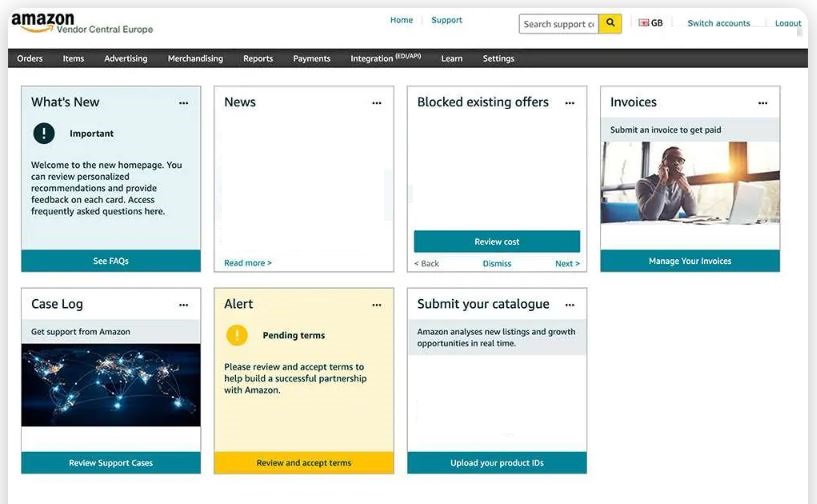
Amazon Vendor Central
- Wholesale model
In AVC, brands sell their products to Amazon in bulk at wholesale prices. The platform purchases the products directly from vendors and takes care of order fulfillment, warehousing, and customer service.
- Amazon as the retailer
Amazon acts as the retailer when you use AVC. That means that Amazon sets the product prices, controls the product listings, and handles most customer interactions.
- Marketing and promotions
Vendors in AVC can access various marketing and promotional tools, including AMS and Vine, to promote their products to a broader audience.
- Invitation-only
Access to AVC is by invitation only, and brands need to meet specific criteria to participate.
Amazon Seller Central
Seller Central is open to third-party sellers, allowing individuals and businesses to list their products on Amazon’s marketplace. Here are some key features.
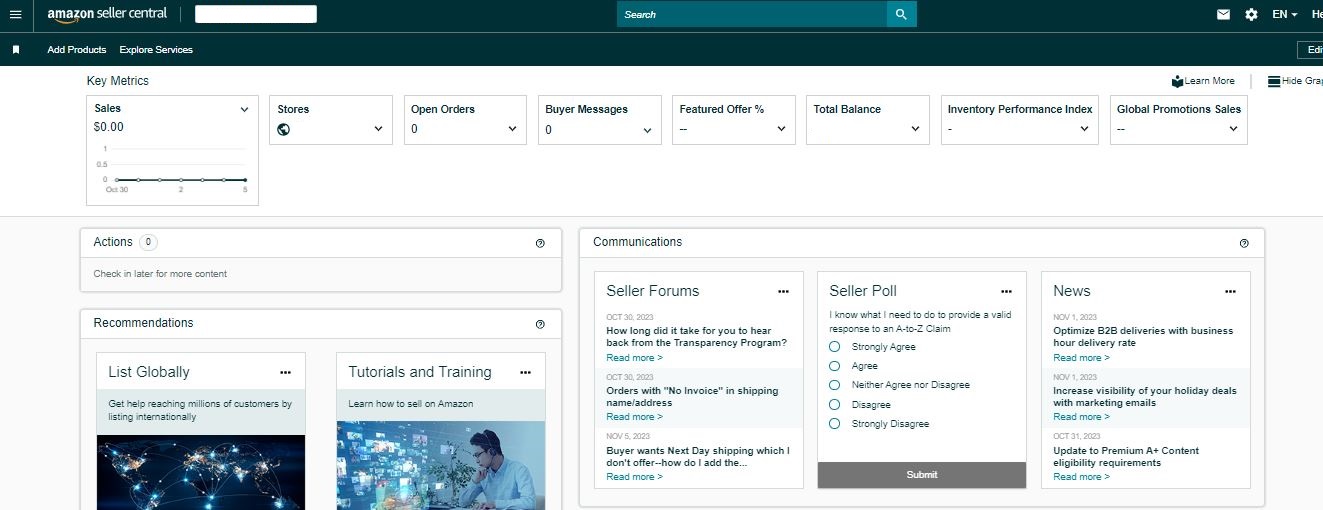
Amazon Seller Central
- Individual and Professional accounts
Sellers can choose between individual and professional selling accounts. Professional accounts offer more features and are suitable for businesses with a more extensive product catalog.
- Fulfillment options
Sellers have the flexibility to choose how they fulfill orders, whether by handling shipping themselves (Fulfillment by Merchant – FBM) or by using Amazon’s fulfillment network (Fulfillment by Amazon – FBA).
- Control over listings
Sellers have more control over product listings, including product titles, descriptions, and pricing. They can also offer products in various conditions (new, used, refurbished, etc.).
- Customer service
Sellers are responsible for customer service, including handling returns and addressing customer inquiries.
- Subscription and referral fees
Sellers in Seller Central pay referral fees and, if applicable, monthly subscription fees based on the selling plan they choose.
Advertising Amazon Vendor Central
Advertising within AVC is a powerful tool for brands and manufacturers looking to increase their product visibility and drive sales on the platform. Amazon offers a suite of advertising options designed to help vendors effectively market their products to a vast audience of potential customers.
Types of advertising within Amazon Vendor Central
- Amazon Marketing Services: AMS is a key component of advertising in Vendor Central. AMS provides various ad formats to promote products, including Sponsored Products, Sponsored Brands, and Sponsored Display ads. These ads appear on Amazon’s search results pages and product detail pages, offering increased visibility to shoppers actively searching for products.
- Sponsored Products: These ads showcase individual products in search results and on product detail pages, helping drive targeted traffic to your product listings.
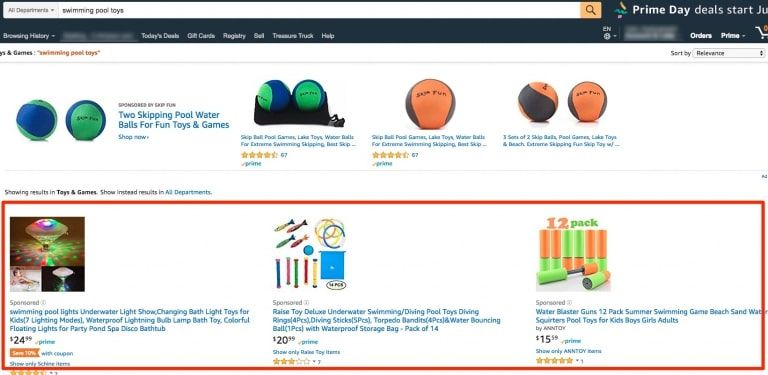
Amazon Sponsored Products ads
- Sponsored Brands: Sponsored Brands ads allow you to feature multiple products along with your brand logo and a custom headline. That is a great way to boost brand recognition.

Amazon Sponsored Brand ads
- Sponsored Display: These ads extend your reach to engage customers on and off Amazon by targeting audiences based on their shopping behavior and interests.
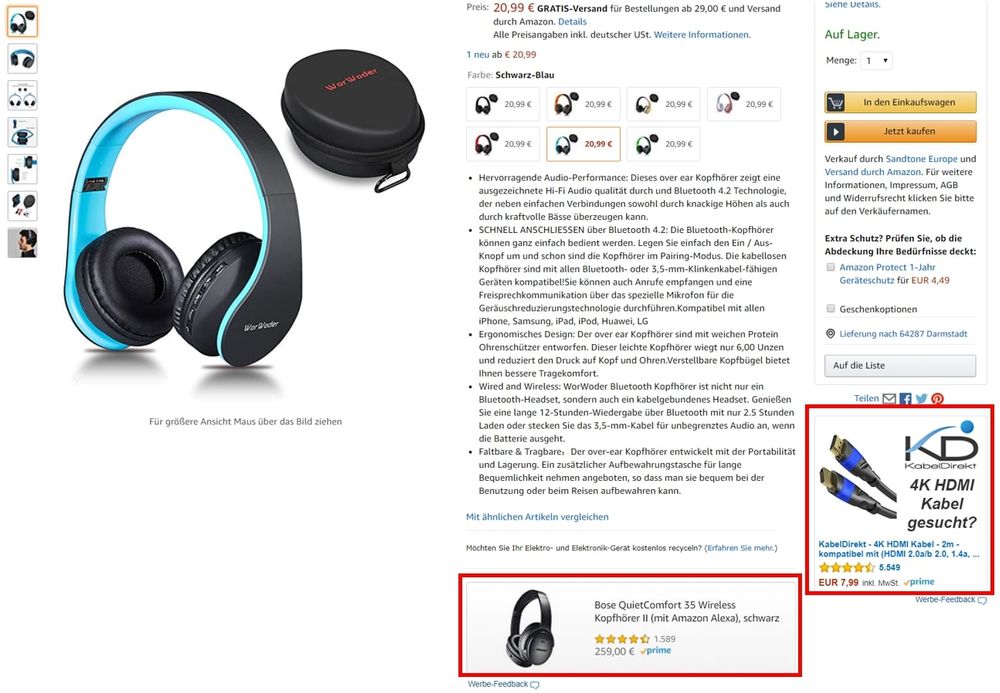
- Amazon Attribution: Amazon Attribution enables vendors to measure the impact of their advertising campaigns across various channels, including off-Amazon sources such as social media and display advertising. This valuable data helps vendors understand the customer journey and optimize their advertising strategies.
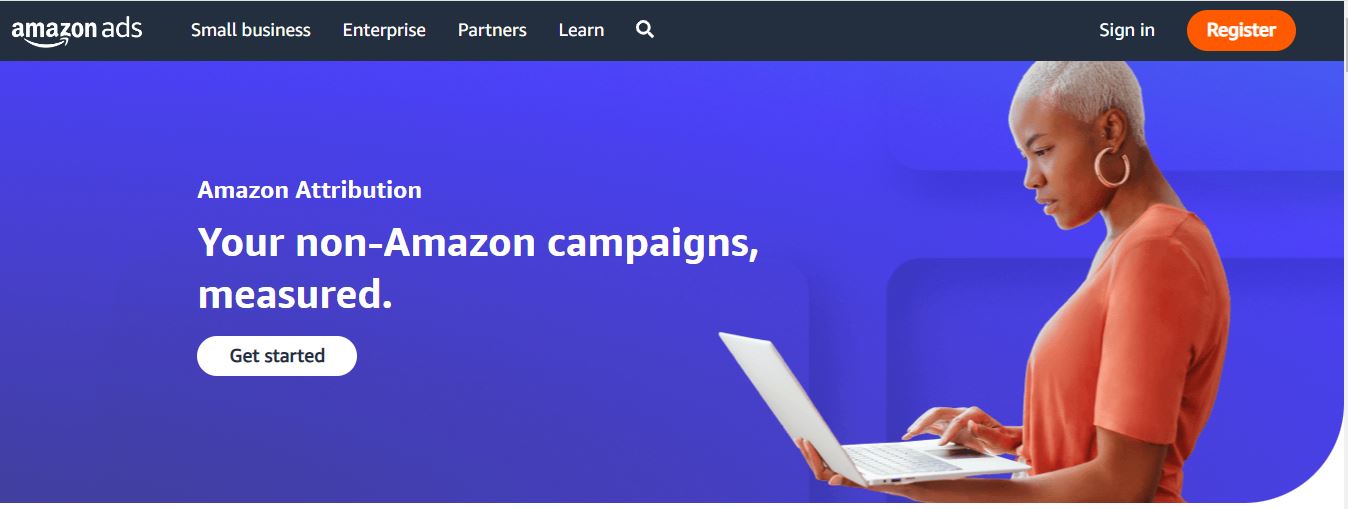
Amazon Attribution page
- Custom Advertising Strategies: Vendors can create custom advertising strategies tailored to their goals. Whether you’re looking to increase sales, drive brand awareness, or launch new products, Vendor Central allows you to adjust your advertising efforts accordingly.
Are you making the most of your Amazon advertising?
Effective advertising within AVC can be a game-changer for your brand, but it’s essential to ensure that you’re maximizing the potential of your advertising campaigns.
Getting the most out of your Amazon advertising efforts involves:
- Data analysis;
- Keyword research;
- Ad creative;
- Optimization;
- Testing and experimentation;
- Monitoring competition.
How Do I Become an Vendor on Amazon?
Becoming a vendor involves a specific process that is typically initiated through an invitation from Amazon itself, allowing you to join the Vendor Central Program. Once invited, you can set up your Amazon Vendor Central Account to start managing your products and sales efficiently.
Steps to becoming a vendor on Amazon
- Step 1. Invitation from Amazon
AVC is an invitation-only program. To become a vendor, you need to be invited by Amazon. Amazon typically extends invitations to brand manufacturers and suppliers based on various factors such as product category, brand reputation, and the potential for a mutually beneficial partnership.
- Step 2. Contact Amazon
If you believe your brand or products align with Amazon’s criteria for a Vendor, you can reach out to them to express your interest. You can contact Amazon through their official website or through your Amazon account representative if you already have one.
- Step 3. Evaluation and onboarding
If Amazon is interested in working with your brand, they will guide you through the onboarding process. This process involves setting up your AVC account, understanding the terms and conditions, and agreeing on pricing and logistics.
- Step 4. Product listings and inventory
You’ll be responsible for providing product information, including product titles, descriptions, images, and pricing. Once your products are in AVC, you’ll need to manage your inventory, ensuring that you have enough stock to fulfill Amazon’s purchase orders.
- Step 5. Performance metrics
Amazon closely monitors your performance as a vendor. It’s essential to meet Amazon’s performance metrics, which may include on-time delivery, order completeness, and product quality. Failing to meet these metrics can lead to issues with your vendor relationship.
- Step 6. Fulfillment and customer service
As a vendor, you manufacture, package, and ship your products to Amazon’s fulfillment centers. Amazon handles the order fulfillment process, shipping the products to customers, and managing customer service.
- Step 7. Advertising and marketing
AVCl offers opportunities for marketing and promotion, including AMS and Amazon Vine. You can use these tools to enhance the visibility of your products.
What Are the Benefits to Your Business with Amazon Vendor Central?
Vendor Central offers several benefits of using Amazon Vendor to businesses, especially brand manufacturers and suppliers. Here are the key advantages.
- Access to Amazon’s vast customer base
By partnering with AVC, your products gain exposure to millions of Amazon customers. That can significantly expand your reach and potential customer base, increasing the visibility and sales of your products.
- Simplified order fulfillment
Amazon takes on the responsibility of order fulfillment, including warehousing, packaging, and shipping. This allows you to focus on your core business operations while Amazon handles the logistics, saving you time and resources.
- Marketing and advertising opportunities
Vendor Central provides access to AMS and other advertising tools. You can run targeted ad campaigns, increase product visibility, and boost brand recognition, ultimately driving more sales.
- Exclusive promotional opportunities
AVC often offers exclusive promotions and deals that can enhance your product’s exposure. These promotions can include Lightning Deals, Best Deals, and other special marketing initiatives.
- Streamlined relationship with Amazon
Vendor Central facilitates a direct and close working relationship with Amazon, allowing for collaboration on product listings, pricing, and inventory management. This collaboration can lead to better communication and improved sales strategies.
How to Optimize Your Vendor Central Listings?
Optimizing your Amazon listings is crucial for higher search rankings and a better shopping experience. Informative, keyword-rich, and visually appealing listings increase your chances of attracting and converting customers. Regularly monitor performance and adjust based on customer feedback and market trends.
For quick and effective listing optimization, consider using tools like SellerSonar. It’s a highly regarded tool known for its features that empower sellers to analyze competitors and maintain a competitive edge.
Noteworthy SellerSonar features
FBA Calculator: Estimate profit margins effectively.
Hijacking Alerts: Protect your listings from unauthorized sellers with immediate alerts.
Competitor Research: Gain a comprehensive understanding of the market and competitors.
Price Change Alerts: Stay updated on competitors’ pricing strategies.
Product Listing Alerts: Monitor your Amazon business environment.
Product Review and Rating Alerts: Enhance your online reputation.
Amazon Keyword Rank Tracker: Optimize your product positioning in search results.
Amazon BSR Tracker: Stay informed about your seller ranking.
Product Suppression Alerts: Address product suppression issues swiftly.
Try SellerSonar now. Register for our 29-day trial and boost your incredible journey of running your business on the platform.
Conclusion
Amazon Vendor Central offers a unique opportunity to partner with one of the world’s largest marketplaces.
Whether you’re a seasoned vendor or just embarking on your e-commerce journey, understanding the intricacies of Vendor Central is essential for your success on Amazon.
With the right approach, you can tap into Amazon’s vast customer base and boost your brand’s presence and sales. We wish you all the best in your endeavors as an Amazon vendor and hope this guide serves as a valuable resource on your journey to success.


